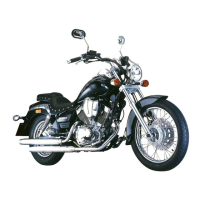
Do you have a question about the American Lifan 250-B and is the answer not in the manual?
| max power | t3/8000 kwr/min |
|---|---|
| max torque | t916000 N.m/r/min |
| top design speed | > 1 km/h |
| grade ability | > 20° |
| engine oil | SAE 15w/40-SE |
|---|---|
| engine oil capacity | 1.2 L |
| fuel | Unleaded gasoline with RQ-93 or higher |
| transmission | 5-speed, constant mesh |
| primary reduction ratio | 3.130 |
| final reduction ratio | 2.812 |
| spark plug | ATTC Model 2V49FMM |
| displacement | 248.9 ml |
| bore x stroke | 49 mm x 66 mm |
| compression ratio | 10.0:1 |
| front tyre size/pressure | 3.0-18/200kPa |
|---|---|
| rear tyre size/pressure | 5.0-15/225kPa |
| front shock absorber | Telescopic type hydraulic drive |
| rear shock absorber | Coil spring-dampened |
| front brake type | Disc |
|---|---|
| rear brake type | Drum |
| battery | 12V 10Ah |
|---|---|
| headlight | 12V-35W/35W |
| winker | 12V-10W |
| tail/stop light | 12V-5W/21W |
| horn | 12V |
| odometer light | 12V-3W |
| fuse | 20A |
| fuel tank capacity | 14 L |
|---|
| overall dimensions | 2250 mm x 850 mm x 1140 mm |
|---|---|
| ground clearance | 150 mm |
| wheelbase | 1495 mm |
| kerb weight | 163 kg |
| max weight capacity | 150 kg |
| turning circle diameter | 4800 mm |
Key warnings, safety guidelines, and operational notices.
General safety guidelines and legal requirements for riding.
Essential protective gear for rider and passenger safety.
Warnings against unauthorized modifications and their consequences.
Guidelines for safely carrying cargo and passengers.
Advice on selecting and installing genuine or compatible accessories.
Diagrams identifying key motorcycle components.
Section to record VIN and engine code for identification.
Guidelines for selecting and using fuel and engine oil.
Identification and function of dashboard meters and indicators.
Operation of the ignition switch, parking, and steering lock.
Controls located on the right handlebar, including starter and emergency switch.
Controls on the left handlebar, including turn signals and horn.
Location and operation of the choke lever.
Procedures for refueling and handling the fuel filler cap.
Operation and positions of the fuel cock (ON, OFF, RES).
Explanation of the 5-speed gear system and pattern.
Function of the rear brake pedal and stop light.
Adjustment of rear shock absorber preload for riding conditions.
Proper use and positioning of the side stand.
Essential checks before riding the motorcycle.
Step-by-step guide for starting the engine.
Recommended procedure for the initial 1000km break-in period.
Basic instructions for operating the motorcycle.
Procedures for stopping and parking the motorcycle safely.
Description of tools provided for roadside repairs and adjustments.
Recommended service intervals and tasks for maintenance.
Procedures for checking and changing engine oil.
Instructions for cleaning carbon deposits from engine parts.
Checking and replacing the spark plug.
Cleaning and maintenance of the air cleaner element.
Importance of valve clearance and when to check it.
Maintenance of the exhaust muffler.
Explanation of the electronic aeration system's principle and features.
Checking and adjusting throttle grip free play.
Adjusting the idle speed of the carburetor.
Checking for leaks in the air supply system.
Adjusting the clutch lever free play.
Checking and lubricating the drive chain.
Checking and adjusting the front brake.
Checking and adjusting the rear brake pedal free play.
Adjusting the rear brake light switch.
Using wear indicators for front and rear brakes.
Checking the shock absorbers and suspension.
Recommended tyre air pressure for various conditions.
Minimum tread depth for tyre replacement.
Procedure for removing and installing the front wheel.
Procedure for removing and installing the rear wheel.
Location and function of the fuse.
Maintenance and handling of the battery.
Steps to diagnose and fix common engine starting problems.
Procedures for cleaning and storing the motorcycle.
Steps for preparing a stored motorcycle for use.
Information about the optional anti-theft device.